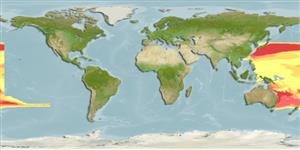>
Acropomatiformes (Oceanic basses) >
Acropomatidae (Lanternbellies, temperate ocean-basses)
Etymology: Acropoma: Greek, akro = topmost, summit + Greek, poma, -atos = cover (Ref. 45335); lecorneti: Cette espèce est dédiée au patron pêcheur M. Lecornet qui l'a prise à bord du 'Thalassa' (propriétaire M. Haller).
Eponymy: D Lecornet was the fisherman on board the Thalassa, who caught the holotype off New Caledonia. Nothing further was recorded. (Ref. 128868), visit book page.
Environment: milieu / climate zone / depth range / distribution range
Ökologie
seewasser bathypelagisch; tiefenbereich 275 - 360 m (Ref. 117016). Deep-water
Verbreitung
Länder | FAO Gebiete | Ecosystems | Vorkommen | Point map | Einführungen | Faunafri
Western Pacific: East China Sea, Japan (Okinawa), NE Taiwan, off New Caledonia and Vanuatu.
Size / Gewicht / Alter
Maturity: Lm ? range ? - ? cm
Max length : 32.6 cm SL Männchen/unbestimmt; (Ref. 117016)
Kurzbeschreibung
Bestimmungsschlüssel | Morphologie | Morphometrie
Rückenflossenstacheln (insgesamt) : 9; Rückenflossenweichstrahlen (insgesamt) : 10; Afterflossenstacheln: 3; Afterflossenweichstrahlen: 7. This species is distinguished from its congeners by the following set of characters: O-shaped luminous gland around the anus; luminous-gland length 13.2-14.6; proximal radial of the first anal-fin pterygiophore is slender lacking trough or hollow; anus pale, situated closer to the pelvic-fin origin than to that of anal fin; gill rakers 14-27; scales ctenoid except for the axil of pectoral fin and cheek (cycloid) (Ref. 117016)
Life cycle and mating behavior
Geschlechtsreife | Fortpflanzung | Ablaichen | Eier | Fecundity | Larven
Okamoto, M. and H. Motomura, 2017. An additional specimen of a rare lanternbelly Acropoma lecorneti Perciformes: Acropomatidae) from Vanuatu, South Pacific Ocean. Cybium 41(4):373-375. (Ref. 117016)
IUCN Rote Liste Status (Ref. 130435: Version 2024-1)
Bedrohung für Menschen
Harmless
Nutzung durch Menschen
Tools
Zusatzinformationen
Download XML
Internet Quellen
Estimates based on models
Preferred temperature (Ref.
123201): 13.5 - 19, mean 16.4 °C (based on 7 cells).
Phylogenetic diversity index (Ref.
82804): PD
50 = 0.5156 [Uniqueness, from 0.5 = low to 2.0 = high].
Bayesian length-weight: a=0.01148 (0.00474 - 0.02781), b=3.00 (2.79 - 3.21), in cm total length, based on LWR estimates for this (Sub)family-body shape (Ref.
93245).
Trophic level (Ref.
69278): 3.7 ±0.5 se; based on size and trophs of closest relatives
Widerstandsfähigkeit (Ref.
120179): mittel, Verdopplung der Population dauert 1,4 - 4,4 Jahre. (Preliminary K or Fecundity.).
Fishing Vulnerability (Ref.
59153): Low to moderate vulnerability (30 of 100).
